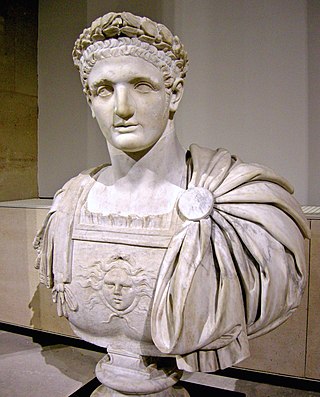
Domitian was Roman emperor from 81 to 96. The son of Vespasian and the younger brother of Titus, his two predecessors on the throne, he was the last member of the Flavian dynasty. Described as "a ruthless but efficient autocrat", his authoritarian style of ruling put him at sharp odds with the Senate, whose powers he drastically curtailed.

AD 79 (LXXIX) was a common year starting on Friday of the Julian calendar. At the time, it was known as the Year of the Consulship of Titus and Vespasianus. The denomination AD 79 for this year has been used since the early medieval period, when the Anno Domini calendar era became the prevalent method in Europe for naming years.

The 60s decade ran from January 1, AD 60, to December 31, AD 69.

The 70s was a decade that ran from January 1, AD 70, to December 31, AD 79.

The 80s was a decade that ran from January 1, AD 80, to December 31, AD 89.

The 90s was a decade that ran from January 1, AD 90, to December 31, AD 99.

The Arch of Titus is a 1st-century AD honorific arch, located on the Via Sacra, Rome, just to the south-east of the Roman Forum. It was constructed in c. AD 81 by Emperor Domitian shortly after the death of his older brother Titus to commemorate Titus's official deification or consecratio and the victory of Titus together with their father, Vespasian, over the Jewish rebellion in Judaea.

The gens Julia was one of the most prominent patrician families in ancient Rome. Members of the gens attained the highest dignities of the state in the earliest times of the Republic. The first of the family to obtain the consulship was Gaius Julius Iulus in 489 BC. The gens is perhaps best known, however, for Gaius Julius Caesar, the dictator and grand uncle of the emperor Augustus, through whom the name was passed to the so-called Julio-Claudian dynasty of the first century AD. The nomen Julius became very common in imperial times, as the descendants of persons enrolled as citizens under the early emperors began to make their mark in history.
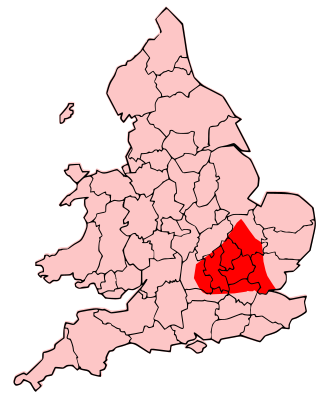
The Catuvellauni were a Celtic tribe or state of southeastern Britain before the Roman conquest, attested by inscriptions into the 4th century.
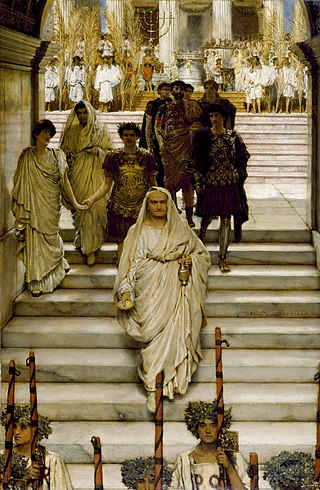
The Flavian dynasty ruled the Roman Empire between AD 69 and 96, encompassing the reigns of Vespasian (69–79), and his two sons Titus (79–81) and Domitian (81–96). The Flavians rose to power during the civil war of 69, known as the Year of the Four Emperors. After Galba and Otho died in quick succession, Vitellius became emperor in mid 69. His claim to the throne was quickly challenged by legions stationed in the eastern provinces, who declared their commander Vespasian emperor in his place. The Second Battle of Bedriacum tilted the balance decisively in favour of the Flavian forces, who entered Rome on 20 December. The following day, the Roman Senate officially declared Vespasian emperor of the Roman Empire, thus commencing the Flavian dynasty. Although the dynasty proved to be short-lived, several significant historic, economic and military events took place during their reign.
Aulus Didius Gallus Fabricius Veiento was a Roman senator who played a major role in the courts of several Roman emperors during the first century AD. For his usefulness, Veiento was rewarded with the office of suffect consul three times in a period when three consulates were very rare for non-members of the Imperial family.

Sextus Calpurnius Agricola was a Roman senator and general active during the 2nd century. He was consul suffectus with Tiberius Claudius Julianus for the nundinium of September-October 154. Agricola is known primarily from inscriptions.
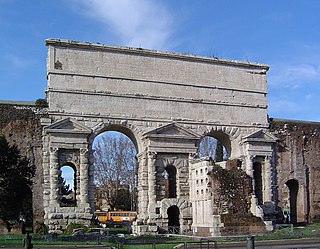
The Porta Maggiore, or Porta Prenestina, is one of the eastern gates in the ancient but well-preserved 3rd-century Aurelian Walls of Rome. Through the gate ran two ancient roads: the Via Praenestina and the Via Labicana. The Via Prenestina was the eastern road to the ancient town of Praeneste. The Via Labicana heads southeast from the city.

The Temple of Vespasian and Titus is located in Rome at the western end of the Roman Forum between the Temple of Concordia and the Temple of Saturn. It is dedicated to the deified Vespasian and his son, the deified Titus. It was begun by Titus in 79 after Vespasian's death and Titus's succession. Titus’ brother, Domitian, completed and dedicated the temple to Titus and Vespasian in approximately 87.
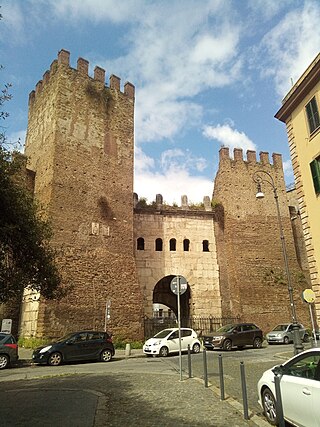
Porta Tiburtina or Porta San Lorenzo is a gate in the Aurelian Walls of Rome, Italy, through which the Via Tiburtina exits the city.
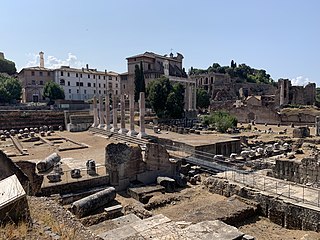
The Temple of Peace, also known as the Forum of Vespasian, was built in Rome in 71 AD under Emperor Vespasian in honour to Pax, the Roman goddess of peace. It faces the Velian Hill, toward the famous Colosseum, and was on the southeast side of the Argiletum.
Titus Flavius T. f. T. n. Sabinus was a Roman politician and soldier. A native of Reate, he was the elder son of Titus Flavius Sabinus and Vespasia Polla, and brother of the Emperor Vespasian.
The gens Minicia was a plebeian family at ancient Rome. Members of this gens are first mentioned in the first century, achieving the consulate under the emperor Claudius. Owing to the similarity of their names, the Minicii are regularly confused with members of the ancient and far more prominent gens Minucia.

Titus Atilius Rufus was a Roman senator, who held several appointments during the reigns of Nero, Vespasian and Domitian. He was suffect consul in some nundinium prior to the year 80. He is known primarily from inscriptions.
Plotius Firmus was a Roman knight and senator who flourished in the sixties of the first century AD. He started his career in the army as a simple soldier, and in 69 AD, during the reign of Galba he was praefectus vigilum in Rome, helping Otho to oust the emperor. After Galba's seizure of power, he was acclaimed by the soldiers praefectus praetorio, and remained quite popular with the military. After Otho's defeat at Bedriacum he encouraged the depressed Emperor who wanted to quit his power to persevere. Despite that, Otho killed himself, and Plotius found him in his chamber lying in his blood.After the suicide of his patron, Plotius tried to rapproach himself with Vitellius, but was prevented to do that by his soldiers. It cannot be excluded that he managed to be pardoned later, but after the end of the 69 AD crisis there are two possible hypotheses: he could either have been the adoptive father or father of C. Tullius Capito Pomponianus Plotius Firmus, or under Vespasian he could have been adopted by the senator Gaius Tullius Capito Pomponianus, taking himself the name Gaius Tullius Capito Pomponianus Plotius Firmus. Thereby he gained entry into the ordo senatorius, and was immediately sent to the military district of Numidia as legate of the Legio III Augusta.
















